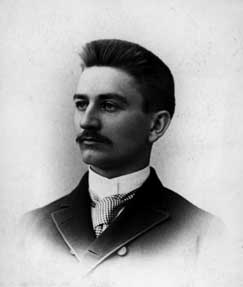<Back to Index>
- Chemist Herbert Henry Dow, 1866
- Composer Stefano Landi, 1587
- Tsar of Bulgaria Ferdinand I, 1861
PAGE SPONSOR


Herbert Henry Dow (February 26, 1866 – October 15, 1930) was a Canadian born, American chemical industrialist. He attended the Case Western Reserve University in Cleveland, Ohio, where he became a member of the Phi Kappa Psi fraternity. His most significant achievement was as founder and eponym of Dow Chemical Company, which was incorporated with 57 original stockholders in 1897. Two years later, he also started the Dow Gardens in Midland, Michigan, as a personal hobby. H.H. Dow High School in Midland, Michigan, is named after Dow. Among his awards is the Perkin Medal, received in 1930.
Herbert Henry Dow was born in 1866 in Belleville, Ontario (Canada), the eldest child of Joseph Henry Dow, an inventor and mechanical engineer. Six weeks after his birth, the family returned to their hometown of Derby, Connecticut. They moved again in 1878, this time to Cleveland, Ohio (USA), to follow his father's job with the Derby Shovel Manufacturing Company. Dow was a precocious child, often helping his father with mechanical problems, and inventing an incubator for chicken eggs before he was 12. Several years later he and his father coinvented a small steam turbine which the United States Navy used for many years in torpedo propulsion.
After graduating from high school in 1884, Dow enrolled in what is now Case Western Reserve University, then known as the Case School of Applied Science. While at Case, he began researching which chemicals could be found in brines in Ohio and other areas of the United States. He discovered that brine samples from Canton, Ohio, and Midland, Michigan, were very rich in bromine, which at the time was a primary ingredient in medicines and was used heavily in the fledgeling photographic industry. Following his graduation from Case in 1888, Dow worked for a year as a chemistry professor at Huron Street Hospital College in Cleveland, still continuing his research into the extraction of chemicals from brine. In 1889 Dow received his first patent after inventing a more cost effective and streamlined process for extracting bromine from brine. He quickly formed his own company, but was bankrupt within the year. His associates were impressed with his work and in 1890 helped him to found the Midland Chemical Company in Midland, Michigan. Dow continued his work for extracting bromine and by early 1891 he had invented a method of bromine extraction that became known as the Dow process, using electrolysis to successfully oxidize bromide to bromine.
Dow
was not content with simply improving the bromine
extraction process,
but wanted to expand his research of electrolysis
to yield other
chemicals. His financial backers did not approve
of his continued
research and fired him from the Midland Chemical
Company. He
continued his research, developing a process to
extract chloride and
caustic soda from sodium chloride. After seeking
funding from potential
backers in Cleveland including family friends and
former Case School of
Applied Science classmates, Dow secured funds from
James T. Pardee,
Albert W. Smith, J.H. Osborn, and Cady Staley. In
1895, Dow moved his
family to Ohio and founded the Dow Process Company
to develop the
production mechanism for his process. The
following year he returned to Midland, where he
formed the Dow Chemical Company as
successor to the Dow Process Company. Within three
years, his new company had purchased the Midland
Chemical Company.
With
his
new company and new technology, Dow was able to
produce bromine
very cheaply, and began selling it in the United
States for 36 cents
per pound. At the time, the government supported
German bromine cartel, Bromkonvention, had
a near monopoly on
the supply of bromine, which they sold for 49 cents
per pound. The
Germans had made it clear that they would flood the
American market
with cheap bromine if Dow attempted to sell the
element abroad. In 1904
Dow defied the cartel by beginning to export his
bromine at its cheaper
price to England. A few months later, an angry
Bromkonvention
representative visited Dow in his office and reminded
him to cease
exporting his bromine.
Unafraid,
Dow continued exporting to England and Japan. The
German cartel
retaliated by flooding the US market with bromine at a
mere 15 cents a
pound in an attempt to put him out of business. Dow,
unable to compete
with the attempt at
predatory pricing in
the U.S., instructed his agents to quietly buy up
hundreds of thousands
of pounds of the German bromine locally at the low
price. The Dow
company then turned the tables on the cartel by
repackaging the bromine
and exporting it to Europe, including Germany, at 27
cents a pound. The
cartel, expecting Dow to go out of business, was
unable to comprehend
what was driving the enormous demand for bromine in
the U.S., and where
all the cheap imported bromine flooding their market
was coming from.
They even suspected their own members of violating
their price fixing
agreement and selling in Germany below the cartel's
fixed cost. The
befuddled cartel continued to slash prices on their
bromine in the
U.S., first to 12 cents a pound, and then to 10.5
cents per pound. Dow
continued selling the dumped bromine in Germany at 27
cents per pound.
When the cartel finally caught on to Dow's tactic,
they realized they
could not keep selling below cost, and were forced to
increase their
prices worldwide. Dow's triumph has been used as an
argument that predatory pricing is an
irrational practice that would never work in the real
world.
The new company focused on research, and soon was able to extract many more chemicals from brine. The company was given a large opportunity to grow during World War I, when Britain blockaded the ports of Germany, which at the time included most of the world's largest chemical suppliers. Dow Chemical quickly moved to fill the gap, producing magnesium for incendiary flares, monochlorobenzene and phenol for explosives, and bromine for medicines and tear gas. By 1918, 90% of the Dow Chemical Company production was in support of the war effort. During this time period, Dow also created the diamond logo that is still used by the Dow Chemical Company.
Following the conclusion of the War, Dow began to research the benefits of magnesium, which the company had in large supply. He discovered that it could be used to make automobile pistons. The new pistons proved to give more speed and better fuel efficiency. The Dow metal pistons were used heavily in racing vehicles, and the 1921 winner of the Indianapolis 500 used the Dow metal pistons in his vehicle.
By the time of his death on October 15, 1930, from cirrhosis of the liver, Dow had personally received over 90 patents. Dow was survived by his wife, Grace, and five of their seven children. His home in Midland, known as Herbert H. Dow House, was declared a U.S. National Historic Landmark in 1976.